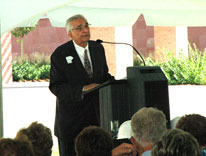
By Chris Casey | University Communications
AURORA, Colo. - University officials, faculty and donors celebrated the visionary leadership of former Health Sciences Center Chancellor Vincent Fulginiti, MD, with the dedication of the Fulginiti Pavilion for Bioethics and Humanities on Monday.
The two-story pavilion, which officially opens Sept. 7, sits between the Education 1 and Education 2 buildings on the Anschutz Medical Campus.
The commitment of Fulginiti and his wife, Shirley, to the ethical and humanistic implications of health care can be traced to pioneering programs across the campus. The Fulginitis, along with founding center director Mark Yarborough, PhD, led the creation of the Center for Bioethics and Humanities and its advisory board, the establishment of a national ethics and genetics conference and the interprofessional ethics course for all doctoral students on the campus.
Scenes from the Fulginiti Pavilion dedication:
|
University of Colorado President Bruce Benson joined Chancellor Don Elliman, School of Medicine Dean Richard Krugman, MD, and Dori Biester, PhD, executive director of the Center for Bioethics and Humanities, in speaking at the ribbon-cutting ceremony.
Fulginiti served in the Pediatrics Department at the Health Sciences Center from 1961 to 1969 and served the university again from 1993 to 2002, when he was chancellor and then served as a professor of pediatrics. Benson said Fulginiti, as chancellor, was an early champion for converting the Fitzsimons U.S. Army Medical Center into what is now the Anschutz Medical Campus.
"Thanks to Vince's foresight and the stellar work of our faculty, staff, physicians and students, today we have one of the best health campuses in the world," Benson said. "It's appropriate that we honor him with this pavilion, which is a great place for the reflection of our students, faculty, staff, patients and visitors on our wonderful campus."
Elliman explained that the Center for Bioethics and Humanities launched in 1995 to engage health professionals and the greater community in a dialogue about the ethical issues in contemporary health care.
"This building is designed and dedicated to bridge the cultural divide between science and art, to explore the most essential questions about the human experience -- who we are and how we care for one another," Elliman said. "In the context of the entire campus being committed to inventing the future of biomedicine, this facility is intended as a place for people to discuss and reflect on the impact of those inventions."
Krugman said Fulginiti had a vision of building programs, not necessarily physical structures. "When this campus became available interprofessional programs became the hallmark of what we did here, and one of the first was the program in ethics and humanities," he said.
Krugman noted that the building's opening couldn't be timed better, as 640 first-year students will soon spend a day in interprofessional education "to meet each other and start their journey together."
Fulginiti first credited the journey he's taken with his wife, Shirley, for his success at the university. He noted that their children and grandchildren were in the audience of 200 for the occasion.
He thanked many people, including multiple donors who made the building possible, former university president Judith Albino for her support and Yarborough for his vision in founding the bioethics and humanities program. "Some of the most original activities in the United States (in the field) took place on this campus."
The pavilion includes an art gallery, Gossard Forum, faculty and staff offices, conference rooms and the John A. Sbarbaro, MD, Ethics and Humanities Terrace. Faculty for interprofessional education will be housed in the pavilion's garden level.
"The real purpose of this pavilion is to provide a philosophic home for the important marriage of ethics, humanities and the science of health care," Fulginiti said. "We hope that in the research, clinical care and education, these programs will prosper on this campus."
Fulginiti said the years that he and his wife spent at the university were "among the best of our lives -- both personally and professionally."
Krugman noted that, thanks to the Fulginitis and other visionaries at the university and donor community, the best years are still to come for the Center for Bioethics and Humanities and interprofessional education.
"The building is done. It’s time to build the program," Krugman said. "Just as this campus has fulfilled Vince’s vision of it being a world-class place, we can have a world-class ethics and humanities program within these walls."
For more information about the Fulginiti Pavilion for Bioethics and Humanities visit its website here.
(Photo: Vincent Fulginiti makes remarks during the dedication ceremony of the Fulginiti Pavilion for Bioethics and Humanities on Aug. 27.)
Contact: christopher.casey@ucdenver.edu
